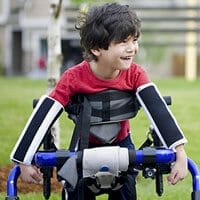All soon-to-be parents pray for a healthy baby. Unfortunately, whether from a congenital disorder, environmental complication or medical malpractice, not all children are born healthy.
A Diagnosis of Cerebral Palsy
While some disorders can be diagnosed immediately, oftentimes cerebral palsy takes months, and sometimes even years, to conclusively diagnose.
The CDC defines cerebral palsy as, “a group of disorders that affect a person’s ability to move and maintain balance and posture. CP is the most common motor disability in childhood.”
It is estimated that CP affects 1 of every 323 children in the United States, and there is no known cure; what is known is that CP doesn’t always develop in the womb.
10 percent by injuries after birth.
No singular test can conclusively determine a cerebral palsy diagnosis. Physicians depend on a multi-step evaluation process. A pediatrician will take into consideration motor skills, reflexes, coordination, muscle tone and the overall development of the child.
Types and Causes of Cerebral Palsy
There are two types of cerebral palsy: Congenital CP and Acquired CP.
1. Congenital Cerebral Palsy (CP)
The CDC has not identified one cause, but have defined risk factors that may help determine the cause. They include:
- Low birth weight. Newborns less than 5-1/2 pounds at birth have a greater chance of having CP.
- Premature birth. Children born before the 37th week of pregnancy, especially if they were born before the 32nd week of pregnancy.
- Multiple births. Twins, triplets, and other multiple births have a higher risk for CP, especially if a baby’s twin or triplet dies before birth or shortly after birth.
- Assisted reproductive technology (ART) infertility treatments. Children born from pregnancies resulting from the use of some infertility treatments have a greater risk. Most of the increased risk is explained by preterm delivery or multiple births, or both.
- Infections, especially viruses including chicken pox, rubella and cytomegalovirus (CMV) can lead to increases in certain proteins called cytokines, which cause inflammation, that circulate in the brain and blood of the baby during pregnancy.
- Jaundice and kernicterus. Jaundice occurs when a chemical called bilirubin builds up in the baby’s blood, which causes kernicterus. This can cause CP and other conditions.
- Medical conditions of the mother. Mothers with thyroid problems, intellectual disability, or seizures have a slightly higher risk of having a child with CP.
- Birth complications. Detachment of the placenta, uterine rupture, or problems with the umbilical cord during birth can disrupt oxygen supply to the baby and result in CP.
2. Acquired Cerebral Palsy (CP)
The second type of CP is called Acquired CP. This occurs more than 28 days after birth, and may be caused by:
- Infection. Infections of the brain — for example, meningitisor encephalitis — during infancy.
- Injury. Injuries to the brain — for example, head injuries caused by motor vehicle crashes or child abuse.
- Problem with blood flow to the brain. Cerebrovascular accidents — for example, stroke or bleeding in the brain associated with a blood clotting problem, blood vessels that didn’t form properly, a heart defect that was present at birth, or sickle cell disease.
Risk factors for Acquired CP include:
- Infancy. Infants are at greater risk of a brain-damaging event than older children.
- Preterm or low birth weight. Children born preterm or at low birthweight are at greater risk for acquired CP.
- Brain infections. Not getting certain vaccinations increases the risk of brain infections that can result in CP.
- Injury. Inadequate safety measures or lack of adult supervision can increase the risk of injury that can result in CP.
What is the Treatment for Cerebral Palsy?
There is no known cure for cerebral palsy, although funding and research are ongoing. However, there is treatment. CP is so various in scope, including severity and symptoms, that each treatment program is unique. However, some basic goals apply to all treatment plans:
 Optimize mobility
Optimize mobility- Manage primary conditions
- Control pain
- Prevent and manage complications, associative conditions and co-mitigating factors
- Maximize independence
- Enhance social and peer interactions
- Foster self-care
- Optimize ability to communicate
- Maximize learning potential
- Provide quality of life.
Determining if there is a Legal Claim
Only an experienced birth injury attorney can help a parent determine if medical malpractice contributed to their child’s cerebral palsy.
Medical negligence can lead to cerebral palsy under a variety of circumstances, including:
- Failure to properly diagnose fetal distress
- Improper reading of a heart monitor
- Failure to act in a timely manner during the birth process
- Improper use of forceps
- Physical injury due to negligence.
It can be distressing for a parent to learn that their child’s birth injury could have been prevented. Consulting with an attorney who can review the medical details of your child’s case is the only way to address the issue of whether medical negligence played a role in the acquisition of cerebral palsy.
Our Arizona Cerebral Palsy Lawyers
Khalidi Law Firm, PLLC has more than two decades’ experience litigating birth injuries and cerebral palsy cases. Located in Tucson’s Barrio Historico, we are very familiar with Arizona law and have successfully pursued justice for those whose child was the victim of a birth injury.
If you believe your child’s cerebral palsy may be due to a medical provider’s negligence, contact Khalidi Law Firm, PLLC as soon as possible for a free consultation.
Medical malpractice cases are handled on a contingency fee basis. We receive no attorney fees unless we secure financial compensation for your injuries. Any expenses advanced by the law firm are recouped from the settlement or judgment.


